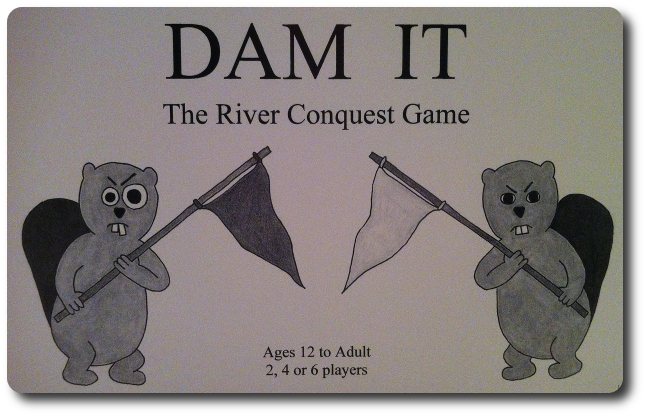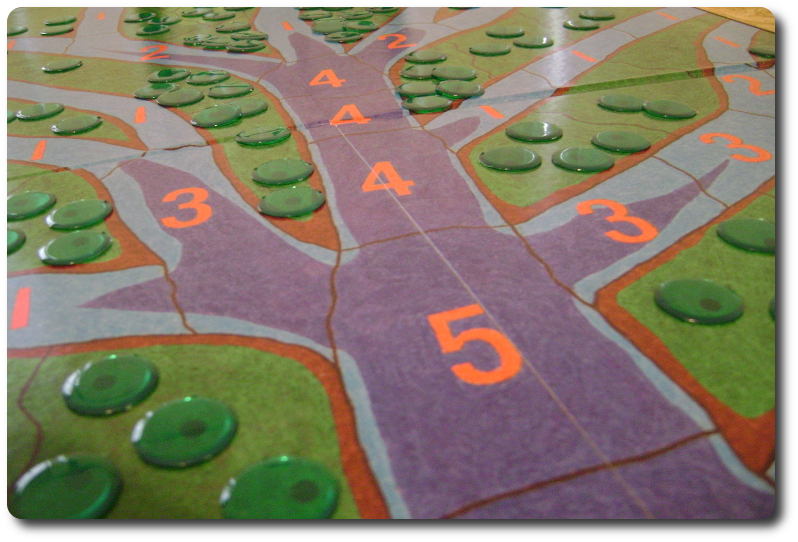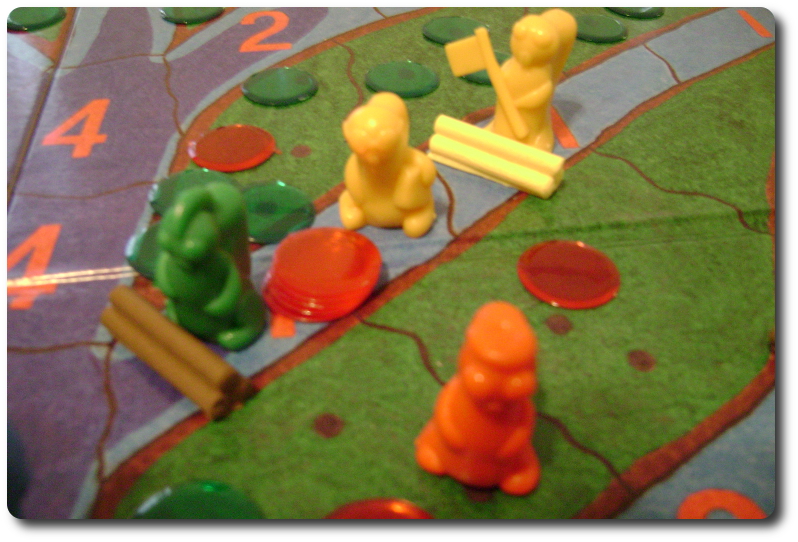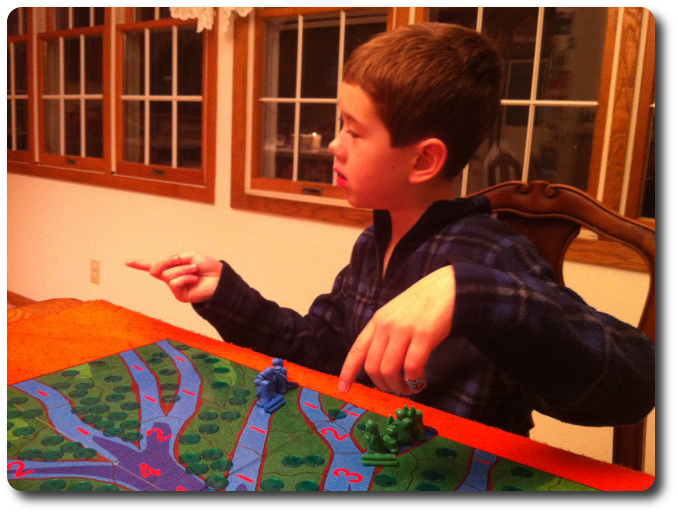
The Basics:
- For ages 8 and up (publisher suggests 12+)
- For 2, 4, or 6 players
- Approximately 1 hour to complete
Geek Skills:
- Active Listening & Communication
- Counting & Math
- Logical & Critical Decision Making
- Strategy & Tactics
- Cooperative & Team Play
- Hand/Resource Management
- Worker Placement & Area Control
Learning Curve:
- Child – Easy
- Adult – Easy
Theme & Narrative:
- Lead your Beaver Clan into combat and build dams to rule the river!
Endorsements:
- Gamer Geek approved!
- Parent Geek approved!
- Child Geek approved!
Overview
The forest is not a peaceful place. While a hiker passing through might capture a glance of a doe and her fawn, see the birds in the trees, and hear the soft babbling of the brook that feeds into the large river, there is a great deal not detected. This forest plays host to a secret war. A battle for resources and control. The rival beaver clans have grouped together with brave leaders on both sides ready for combat. Before the last tree falls, only one Clan Den will prevail!
Dam It: The River Conquest Game, a self-published title by game designer Rodney Benesh, is comprised of 1 game board that represents a large river and its tributaries in a heavily forested area, 2 standard eight-sided dice, 24 Elite Beaver pawns (4 per player, in 6 different colors), 125 Wood Chip tokens (green), 100 Worker Beaver tokens (50 blue, 50 red), 6 Player Den pawns (in 6 different colors, one per player), 10 Tiny Dam pawns, 2 Small Dam pawns, 2 Medium Dam pawns, and 1 Large Dam pawn.
Game Set Up
To set up the game, first unfold the game board and place it in the middle of the playing area.
Second, place 1 green Wood Chip token on every black dot on the land sections of the game board. For example, if one land section has 4 black dots, 4 green Wood Chip tokens will be placed. The black dots are spaced far enough away from each other to allow one Wood Chip token to be placed on each with little to no overlap.

Example of Wood Chip tokens on the game board
Third, divide the players into two even teams and have the players sit around the game board so that each team will alternate turns as game play goes around the table. The game allows for 2 teams comprised of 1 player each, two teams comprised of 2 players each, or two teams comprised of 3 players each. Have each player select 4 Elite Beavers and 1 Player Den pawn that matches the color of their beavers. Players should also take 2 blue or 2 red Worker Beaver tokens (each team will select one of the two colors). Any Elite Beavers and Player Dens not selected are removed for the duration of the game.
Fourth, each player now takes a turn at rolling one of the eight-sided dice. The player who rolls the highest will be the first player for the duration of the game and play will continue going clockwise. Again, make sure that the players are seated around the table so that each team will alternate turns as game play goes around the table. Re-roll to break any ties between the highest rollers.
Fifth, starting with the first player and going clockwise, each player will now place their 4 Elite Beavers, 2 Worker Beaver tokens, and 1 Player Den pawn on any water space on the game board that has the number “1” on it. Teams should feel absolutely free to discuss placement of their beavers, but all discussions are open and at the table. The only rule for initial placement is that each Player Den needs to be at least 2 spaces away from an opponent’s den location. Players who are on the same team can have their Player Dens right next to each other, but they cannot occupy the same space.
Sixth, place the remaining Dams, tokens, and dice to one side of the table and within easy reach of all the players.
That’s it for game set up. Ge to work, beavers!
Busy As A Beaver
The game is played in rounds with each player taking a turn during a single round. A player’s turn is broken down into 5 different phases. Once a player is done with their turn, the next player in clockwise order has their turn. The next player to have their turn should always be a member of the opposite team. In this way, one team will have a turn, then another team, and so on. Players should feel free to talk to each other about their moves during the game and work together to win. A player’s turn is summarized here.
Phase 1: Movement
During this phase of the game, the player can move any number of their Elite Beavers. It might help to consider Elite Beavers as specialized Worker Beavers. Each Elite Beaver is summarize here, as is the Worker Beaver.
- Flag Beaver: The morale booster of the player’s Den that gives a +2 defense bonus when in combat.
- Warrior Beaver: The greatest fighter the player’s Den has ever seen that gives a +2 attack bonus when in combat.
- King Beaver: The leader of the player’s Den that gives a +1 attack and +1 defense bonus when in combat.
- Architect Beaver: The smartest beaver in the player’s Den and the only one who can direct the other beavers to build dams.
- Worker Beaver: The most numerous of the beavers on the river and eager workers who help collect wood, build dams, and provide a +2 attack bonus in combat.
Each Elite Beaver can move up to 2 spaces on the game board. Spaces are divided by solid lines and are either water or land. Movement is not affected by the terrain (in other words, there is no movement penalty when swimming in the water or scampering on the land). When an Elite Beaver moves, they can take any number of Worker Beavers with them that belongs to their team. Worker Beavers cannot move on their own and will only follow an Elite Beaver into a new space.
Note that teams share all Worker Beavers of the same color.

Example of 4 different Elite Beavers on the same team with shared Worker Beavers
A player’s movement is not hindered if they travel through spaces occupied by other team members or any space not currently occupied by beavers. If a player goes into a space occupied by any Elite Beaver or Worker Beavers owned by their opponent, that Elite Beaver’s movement automatically ends.
Teams should coordinate Worker and Elite Beaver movement as much as possible, moving them in position for another player to control or derive bonuses from on their turn.
After all the Elite Beavers with accompanying Worker Beavers have been moved, the next phase is triggered.
Phase 2: Collection
During this phase, the player collects resources. The player removes one Wood Chip token from the game board for every Worker Beaver that shares the same space as the wood. All Wood Chip tokens taken from the game board are shared resources and usable by any member of the team. Players should feel free to place them in a central pile in front of one of their team members for easy organization and withdrawal.
An Elite Beaver need not be with a Worker Beaver to collect a Wood Chip token. Worker Beavers know enough to chop down wood without direction from their Den leaders. However, any space that is in conflict with one or more opponent Elite Beavers does not allow for any Wood Chip tokens to be collected.
Once one Wood Chip token for every one Worker Beaver on the player’s team has been removed for every space that is not in conflict, the next phase is triggered.
Phase 3: Construction
During this phase, the player can have their Architect Elite Beaver build a dam. The Dam is built in the space where the Architect Elite Beaver is currently located. The space cannot contain any other dam, Player Den, or be in conflict. Dams come in four different sizes (tiny, small, medium, and large) and cost wood to build. Building dams help the player and their team control river tributaries and eventually the main river. The more river a team controls, the more beavers will flock to their banner.
In total, there are 15 river tributaries with the smallest parts identified as a “1” and the bigger parts of the river identified with a “6”. To control a tributary and eventually the river, the player must have a dam or a Player Den as close as possible to or on the widest part of the river. In other words, the dam or Player Den that is down river controls everything that is upriver from it. Therefore, if a team ever controls the biggest part of the river, they control everything.
The size of the tributary or the river determines the size of the dam needed and the cost to construct it using the team’s Wood Chip tokens as payment. For example, if building a tiny dam on a “1” river space, it will cost the team 2 Wood Chip tokens. However, that same tiny dam will cost 7 Wood chips if built on a “3” river space. Dams, like the trees they are made of, are a limited resource.
Once dam construction is completed, the next phase is triggered.
Phase 4: Combat
During this phase, any space that is occupied by Elite Beavers belonging to different teams engage in battle. If there is more than one space in conflict, the player determines in which order each battle is resolved. If the space in conflict only contains Worker Beavers that belong to their opponent, each of the opponent’s Worker Beavers are replaced with the player’s Worker Beavers (in other words, the Worker Beavers switch sides). If, however, the space in conflict contains an Elite Beaver belonging to the opponent, the beavers get violent.
Combat is simple and only involves those beavers in the contested area. The player rolls an eight-sided die and any opponent can roll the other. The player is the “Attacker” and gets all the attack bonuses from any Elite Beavers in combat. The opponent is considered the “Defender”, getting all the defense bonuses provided by their Elite Beavers. Worker Beavers only provide an attack bonus. Once the bonuses are added to the rolled values, the player who has the higher of the two values has won the battle.
If the Attacker loses, they move their Elite and Worker Beavers back into the space they were in previously before moving into the space that triggered the conflict. If the Defender loses, they must retreat with their Elite and Worker Beavers to an adjacent “friendly space”. A “friendly space” is defined as any space that contains one or more beavers that belong to the player’s team. If the player is unable to retreat to a “friendly space”, all the Elite Beavers in conflict are removed from the game and all the Worker Beavers immediately switch teams.
Note that Worker Beavers stack. That means a force comprised of 3 Worker Beavers will get a +6 to the combat roll value! Some of the Elite Beavers also provide a bonus that stacks. For example, a player will get a +2 attack bonus for every Warrior Elite Beaver in combat. Not all Elite Beavers get to stack their bonuses, however. For example, only one Flag and one of King Elite Beaver can contribute to the defense bonus, regardless of the number in combat.
Players should take special care to protect their King Elite Beavers. When a player’s King Elite Beaver is removed from the game, any of their remaining Elite Beavers are also removed. The player’s turn is skipped for the duration of the game, but they are welcome to help their team devise a winning strategy. Teams win this game, not individuals.
Once all spaces in conflict have been resolved, the next phase is triggered.
Phase 5: Recruitment
During this phase, the player will attract Worker Beavers to their team. To determine the number of Worker Beavers the team will collect, the player adds up all the dams and Player Dens still under their control. Then the player adds up the number of river tributaries they control based on dam placement. The total is then compared to a table on the back of the game’s rule book which also acts as a quick player reference sheet. The number of reinforcements noted represents the number of Worker Beavers that can now be placed on any space that has a player’s Elite Beaver on it. Note that a dam and a Player Den is only counted if the player’s team controls it. To control a Player Den or dam, at least one Elite or Worker Beaver belonging to their team must occupy the same space.
This ends the player’s turn.
Winning the War on Wood
The game ends when one of the following conditions are met.
- If all the King Elite Beavers are removed from play on one team, the other team wins the game.
- If a Player Den is ever captured and controlled by an opponent, they are out of the game. Capturing all Player Dens belonging to the opponents awards a victory to the occupying team.
- If one team ever dams and controls the “6” spot on the river for 6 turns, they win the game.
- If one team ever controls 50 or more Worker Beavers, they win the game.
Prediction
Dam It is a little like Risk, in the sense that players are moving pieces from one space to another, counting up the total, and the larger army taking control. However, Risk is a very simple area control game and Dam It has a lot more going on which demands more player involvement. More involved, but not more complex. The game’s level of complexity is balanced with team play, allowing younger and inexperienced players to be gently assisted on their turn as needed. This should make the game exceedingly interesting to the Parent and Child Geeks. The Gamer Geeks level of endorsement is a bit too mixed to predict for this game. The game has several characteristics that the Gamer Geeks will consider flaws. For example, the game component quality is not stellar. Very playable, mind you, but obviously a self-published game with little in the way of funds to provide high quality components. If the Gamer Geeks can work past the component quality, I think they’ll enjoy the game a great deal. It’s a bit like serving a meal that doesn’t look appetizing but tastes amazing. If the individuals at the table can ignore the presentation, they’ll find that their dish is surprisingly excellent, despite outward appearances.
Teaching the game is not difficult. In fact, you can teach this game as you play it. Just make sure the players going first know how to play so they can talk to each phase in detail and then help others on their turn. When we played the game, we always made sure to make the teams evenly matched in regards to skill and age. We never put together two teams that only had Parent Geeks and the other Child Geeks, for example. This did wonders for game play and for teaching the game. Even thoughDam It is a game of conquest and conflict, it is played cooperatively. The Child Geeks will greatly benefit from being put on a team where a Parent Geek can teach, lead, and follow all at the same time.
And so, after teaching the game to my little geeks, I asked them their thoughts on Dam It before we played a 4-player river battle.
“It’s a combat game with beavers! Yeah!” ~ Liam (age 8)
“I like how we can work together as a team, Daddy!” ~ Nyhus (age 5)
Putting my 8-year-old’s sarcastic comment aside, both of my little geeks are eager to play. Let’s get to it and see if this game holds water.
Final Word
The Child Geeks had fun with this game, but their level of enjoyment was highly dependent on the team they were on. If they felt like their team leader (and there is always a team leader when playing cooperative games) was giving them the freedom to play their own game, while helping them at the same time, they had a blast. To be fair, the level of enjoyment was also dependent on the Child Geek’s personality. The quiet Child Geeks let others play the game for them resulting in not much fun. Luckily, most of the Parent Geeks who played with them were able to get each of the Child Geeks to engage the game on a level they felt comfortable with. The older Child Geeks enjoyed the combat and the resource gathering, working together as a team. The younger Child Geeks always felt very important and proud when they could help out their team members by moving in Worker Beavers or guarding Player Dens. While our 5-year-old could play the game, we spent a good deal of time helping him. Too much, in fact. Our 8-year-old did awesome on his own, which suggests a Child Geek as young as 8 can play this game with minimal assistance. Regardless of age, the Child Geeks who played the game approved it and very much enjoyed playing Dam It with their family.

My little geek explains his next move to his team member
The Parent Geeks, as you can probably guess, also enjoyed the game. They weren’t fans of the game’s title, however. “When you say the name of the game, all I hear is swearing”, said one Parent Geek. I more or less just rolled my eyes at these comments, but collected them all the same. Must be objective, after all, but the spelling and use of the word is appropriate within the game’s context as defined by the game’s theme. For those Parent Geeks who thought the game’s title was just a bit too “colorful”, I suggested they call it “The Beaver Game”. At which point, some of the more childish Parent Geeks snickered. Once we got past the name, the Parent Geeks thought Dam It was a wonderful cooperative/team play game with resource management and area control. The Parent Geeks approved the game, despite any personal feelings about the game’s title.
It took forever to get this in front of the Gamer Geeks. Again, the game’s presentation is not terrific. It is, at best, functional from the Gamer Geek’s perspective. Before you rage and state that the Gamer Geeks are not being fair, consider how seriously Gamer Geeks take their games and the hobby. They hold games up to a very high standard and sometimes those standards get in the way of their objectivity. When I showed them the game, the usual response was, “looks cheap”. I wouldn’t suggest it looks cheap, but it does look suspiciously handmade. The component mold quality is very passable and everything works together very well. Getting the Gamer Geeks to see the game in action was the trick. Once they did sit down for a game, full of pessimism, they started to ease up. They found Dam It to be a lot of fun, enjoying the strategic movement of beavers, the tactics they needed to use as a team, and the resource management and area control that was necessary to dominate the opposition. The Gamer Geeks approved the game, but wanted me to state that their level of endorsement is based on the game play and not the game’s presentation or component quality. They consider Dam It “slightly better than OK” and would recommend it as a good game for conventions, gatherings of geeks, or when you want to play a game with the family that a Gamer Geek would tolerate.
Personally, I really like Dam It and think it’s excellent for the family gaming table. I found the game to be a lot of fun, challenging, and engaging. It does a great job of introducing and utilizing area control, resource collection, and management, while at the same time requiring strategic movement and tactical combat thinking with a group. This is also one of those rare cooperative/team play games where you can mix and match player’s of different ages and skill levels without upsetting the game’s balance or fun. Really, just a wonderful surprise and one worth playing. Don’t let the lack of luster in this game fool you. It’s pure gold.
This game was given to Father Geek as a review copy. Father Geek was not paid, bribed, wined, dined, or threatened in vain hopes of influencing this review. Such is the statuesque and legendary integrity of Father Geek.



